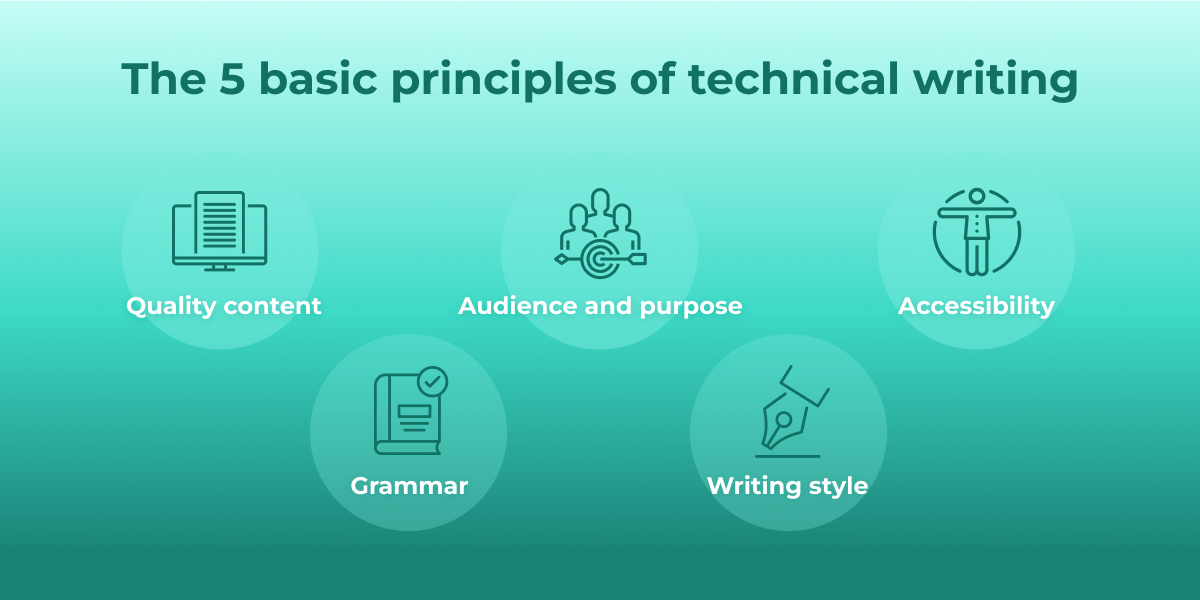Imagine having a tech product so good that it can help you conquer markets in a glimpse of an eye. While your marketers will take you to the new customers, one of your major tasks would be to explain to customers how the product or service benefits them or assists in resolving a particular problem. Your marketing experts themselves will need an explanation. Otherwise, they won’t be able to relay the value your business brings to them, meaning your sales will fail.
Or imagine your business running on several technologies that ensure its smoothness, automation, or agility. The need for explaining these technologies’ workings to your teams, especially the newly-onboarded team members, would be indispensable.
This is exactly where technical writers come to first create and then translate complex technical documentation into something anyone can understand. Technical writing plays a vital role in helping companies create different technical documentation, bringing customers closer to your products and further digitizing business processes.
There’s no wonder that according to the U.S. Bureau of Labor Statistics, the workforce of technical writers is expected to grow/bls.gov/ooh/media-and-communication/technical-writers.htm by 7% from 2023 to 2029. This evidence points out there is a growing demand for technical writers, and what they produce – technical writing. So what exactly can be dubbed as technical writing? Let’s find out in today’s article.
What is Technical Writing?
In a nutshell, technical writing is a specific form that focuses on describing and explaining complex technical information concisely, clearly, and in an easy-to-understand way. The concept usually allows for conveying specialized tech-based information to a selected audience. Technical writers work and produce technical documentation. This entails using specialized terminology coupled with visual aids to ensure the information is presented in an effective and highly organized manner.
Technical writing occupies a significant place in general business writing. Namely, the phenomenon communicates technical information to a broad range of audiences. While used in various industries, for instance, healthcare, finance, IT, and engineering, technical writing makes general business writing more specific. In the same manner, as general business writing, technical writing is there to assist companies in conveying tech ideas to different stakeholders, such as customers, employees, regulators, and investors.
Compared to other kinds of business writing, technical writing relies on an in-depth understanding of the subject matter. Besides, technical writers conduct much stronger research and have comprehensive analytics skills to present technical documentation that translate complex ideas into easy-to-understand content.
The above shows that technical writing is not just about the manual writing of different texts. Instead, it is a complex business tool ensuring the proper documentation of administrative, production, and business processes. It also makes certain these documents are organized and does not rely on person-to-person explanation. Technical writers use an array of different tools to document the business processes mentioned above. It can be diagrams, flowcharts, and other visual aids. Besides, technical writers rely on plain language to make the text understandable to stakeholders.
Now, keep in mind there is a long list of technical documentation technical writers produce:
- Technical documentation
- End-user instructions
- Technical reports
- Feasibility studies and corporate reports
- Research results
- Policies and procedures
- Business plans
- White papers
- Case studies
- Literature reviews
- Proposals
Further in the article, we will discuss each element on the list in greater detail to show how versatile technical writing can be. Now, let’s move further and explore the primary objectives of technical writing.
What is the Goal of Technical Writing?
The primary objective of technical writing is to provide and convey complicated technical information to readers in a way people can comprehend and later use the information. Importantly, the insights can be applied even if readers have no prior expertise or knowledge of what they are reading about. In other words, technical writing aims at translating complex tech-related information into content that even a general audience can understand.
Speaking more specifically about technical writing’s objectives, it enables audiences not only to understand but also to use the information effectively. It does not matter whether the person reading the technical documentation is a customer, a stakeholder, or a coworker, it is vital to present the information that would be relevant to the audience’s expertise and needs.
To show how the aspects above work, consider several key examples:
- The user manuals
These instructions guide users through the entire process of using a particular product. The product can be a washing machine or a complicated software program. Technical writers write these manuals in a step-by-step manner and describe each step in words people who will use the product will understand. - Technical reports
This technical document offers an in-depth analysis of relevant technical information. Technical writers can adopt this type of technical writing in engineering, academic, and scientific domains. It adapts complicated research findings and experimental data into content ordinary people can comprehend. - Business proposals
Companies use this technical document to persuade their customers and clients to purchase a certain product or service. In simple terms, it entails outlining the product’s benefits while explaining how it works and delivers them.
These are only a few examples of how technical writing works. You might have noticed that reaching a particular target audience presents the approach’s core.
Yet, it does not mean that all the proposals, user manuals, and other technical documents are written equally. There are internal and external audiences to mention:
- Internal technical writing documentation is directed at employees working in a company or an organization. Most often, these include training materials, internal reports, and technical specifications. Internal audiences have a technical background and can understand complex tech information.
- External technical writing documentation is directed at audiences without a technical background. It can be clients, customers, and other stakeholders.
There are also external technical audiences with a technical background. These can be engineers, technical consultants, and scientists.
To understand what type of technical documentation you need, knowing what audience to target and what ideas to convey is crucial. Let’s discover some key technical writing types to get a deeper hold of the subject.
The Different Types of Technical Writing
We’ve presented the list of technical documents below at the beginning of this article. Now, it is time to provide some in-detail explanation of what each particular type of technical writing means and represents.
- Technical documentation
This type of technical writing refers to technical information on a product, process, or service. Technical documentation is directed at technical audiences. This type includes technical specifications, installation guides, and technical specifications. Equipped with technical documentation, people can have a clear perspective on how to operate a technical product. - End-user instructions
Such pieces offer users step-by-step instructions on using a product or service. End-user instructions are directed at non-technical audiences and often include aspects such as setting up, operating, maintaining, and troubleshooting a product in question. - Technical reports
This is where in-depth evaluation or assessment of technical information is to be found. Technical reports are directed at external audiences with a technical background. For instance, these are used in academic and scientific domains to communicate varied research data. Remember that technical reports are often written formally and are aided by tables, diagrams, charts, and tables for data illustration purposes. - Feasibility studies and corporate reports
Those types of technical writing are directed at analyzing the overall project’s or product’s feasibility. Feasibility studies and corporate reports offer insights into a project’s technical, financial, and administrative aspects. These documents are vital for making stakeholders’ decision-making much better. - Research results
Writers crafting and complying with research results aim to translate the complex findings of academic or scientific research into something other people can also understand. Research results are often based on explaining the research methodology, conclusions, and results. - Policies and procedures
These will help you guide a person in how to perform particular actions and tasks. Technical writers prepare policies and procedures for a variety of industries. Yet, in most cases, these technical documents prove most important in healthcare and finance. It is a direct way to standardize various processes to ensure all tasks and actions comply with existing regulations. - Business plans
Outlining a certain business’s goals, operations, and strategies is the main task of this type of copy created by technical writers. Business plans provide in-depth information on the niche, market, competitors, financial projections, and resources, which is instrumental when it comes to improved decision-making. - White papers
When looking for a way to showcase your organization’s expertise on a particular matter, issue, or challenge, writing a white paper is the answer. Technical writers work on white paper to deconstruct a particular problem in great detail. Yet, another crucial part of this technical document is providing a robust solution to the issue. White papers are critical in technology and business, namely because these attract stakeholders. - Case studies
Probably one of the most powerful marketing and training artifacts, case studies focus on a specific situation that was dealt with or resolved, and, namely, the solution part will be the one described most extensively. Most often, it includes aspects like challenges, solutions, and results. Often, you can see tech companies having case studies to show how they managed to resolve a particular issue with their client and how they did it. - Literature reviews
Directed at summarizing particular research on a specific topic under investigation, literature reviews are often applied in academic and scientific research to provide a comprehensive angle on the state of knowledge on the selected subject matter. Technical writers with proficiency in literature reviews are not that frequent in business. However, it is still a recognized type of technical writing. - Business Proposals
Business Proposals are aimed to urge customers to purchase a particular product. In most cases, proposals emphasize the benefits a product brings and provide an in-detail explanation of how the product operates. Technical writers design proposals in cooperation with marketing experts.
The types of technical writing above provide an overview of what the concept is all about and how it is represented through a variety of approaches and methods. Next, it is time to explore key characteristics of technical writing.
Key Characteristics of Technical Writing
Technical writing can come in many shapes and forms. Besides, technical writers can produce content of varying quality. At this point, to ensure technical writing comes with top-notch quality, particular phenomenon characteristics must be preserved. Without further ado, let’s proceed to explore this trait.
Clear
One of the foundational aspects of technical writing to be good is to be written clearly and concisely. In other words, a technical writer needs to produce technical documentation that the audience will easily understand, regardless of the level of expertise. At this point, clarity, as a characteristic of technical writing, entails it being unambiguous, without jargon, and with short sentences helping to keep track of the thesis being delivered.
As mentioned above, almost every type of technical writing includes translating complex technical information into something audiences can comprehend. Without the factor of clarity involved, this is almost impossible. It means that a technical writer should be proficient in what a person translates and able to deliver clear writing communication.
Straightforward
Another important characteristic of technical writing is all about straightforwardness. Any piece produced by a technical writer should be to the point. The subject matter must be addressed directly. It means technical writing does not include such aspects as prose or so-called flowery language. Instead, the information must be presented directly without too many unnecessary explanations.
However, you should also understand that being too direct might make technical writing not appealing to readers. It means a technical writer is an expert who finds a fine balance between indirect and overly direct. The best way to be straightforward in technical writing is to use formal language when needed and always rely on robust evidence-based statements.
Problem-solving
The third factor crucial to technical writing is problem-solving. This means a person standing behind technical documentation focuses on producing content that solves particular issues and meets specific needs. However, before solving some problems, it is crucial to identify one. At this point, the problem-solving characteristics of technical writing entail three key components – identifying the issue, explaining the problem, and providing the solution for the challenge at hand.
This characteristic is particularly important in such works of technical writers as white papers and case studies. Namely, these show how a specific issue can be solved with particular solutions. Problem-solving comes toe to toe with an evidence-based approach. It means every argument and hypothesis presented should be rooted in research coupled with robust evidence.
Detailed
Technical writing must be detail-oriented. As a part of the approach, technical writers focus on accurate and precise information. As with problem-solving, this must be backed by data and research. Moreover, being detailed means a technical writing language must not be watery. In other words, a technical writer writes to the point and presents specific details instead of turning to overly abstract descriptions.
Easy to understand
Going further, technical writing should be easy to understand. Technical writers work with a great deal of technical information and data. Besides, there can be technical jargon involved. Respectively, the key objective of technical writing, especially for audiences without a technical background, is to translate a technical narrative into one ordinary people can understand.
That is why technical writers use plain language aided by simple vocabulary and relevant examples. Depending on the technical documentation and their goals, the information delivered to audiences should be accessible and easily comprehended. Keeping that in mind, you can see that technical writing is audience-directed and shaped based on the type of people technical documentation targets.
Duly structured
Finally, technical writing should be structured up to the point that a person reading it should be able to navigate the content easily. From the perspective of technical writers, you must present clear headings and subheadings. Besides, it is crucial to integrate bullet points and numbered lists. Finally, much technical documentation must have a table of contents. All these aspects allow readers to navigate the document and find relevant information in a matter of seconds.
Keeping all the characteristics above, it is apparent that technical writing should be clear, straightforward, problem-solving, detailed, easy to understand, and structured. Even if one of the aspects above is absent, there is a high chance the end product will not reach the intended outcomes. Moreover, when you follow the presented characteristics, you get the baseline for technical writing. Yet, if you want to improve technical writing, there are several key principles.
The 5 Basic Principles of Technical Writing
As a specialized form of writing, technical-based writing should be able to communicate complex ideas concisely and clearly.

In turn, to have technical writing that delivers and provides intended advantages, there are 5 principles to follow. These are the ones to mention:
- Quality content
- Audience and purpose
- Accessibility
- Grammar
- Writing style
Quality content
Perhaps, the quality of the technical content is one of the vital principles of technical writing. It means that technical writers must present accurate, relevant, and complete information. What is more, the top-notch quality content must be organized coherently and logically with a clear structure. As a result, it means that a technical writer working on a technical document should focus on the quality of the content first and foremost.
Audience and purpose
When it comes to designing and writing a technical document that delivers, it should be made with both an audience and purpose in mind. This entails understanding what skills, knowledge, and needs the intended audience has. In such a case, a technical writer adjusts the content to audience-based factors. Finally, when doing all that, it is crucial to remember the purpose. By all means and during all the steps of writing the technical content, it must always be aligned with the intended goals and directed toward the intended audience.
Accessibility
The next principle that lies at the core of technical writing is the factor of accessibility. In a nutshell, it means a product delivered by a technical writer should be accessible to all kinds of readers, regardless of the technical level and knowledge background. From a writing standpoint, it means a writer working with technical content should use clear and concise language. Narrowing it does, entails sentences with simple structures, as well as avoidance of jargon along with overly complex technical terms.
Besides, for technical writing to be more accessible, it is important to use visual aids. Diagrams, illustrations, and charts serve as factors in delivering knowledge to readers without a technical background. As we mentioned above, technical writing is audience-oriented. In such a case, accessibility is the key principle in technical-based insights reaching intended audiences.
Grammar
Going further, good technical writing comes with a good grammar structure. It entails technical writers using correct punctuation, spelling, and grammar to clarify the presented content. In turn, it is also crucial to understand the adverse impact of improper grammar on the quality of technical content. Grammar errors, as well as spelling, leave readers confused. Besides, a lack of proper grammar can result in misinterpretation of information. In this case, technical writing won’t reach the intended purpose.
Writing style
The final principle of good technical writing is the writing style. In short, it means a technical writer should use a writing style that delivers content clearly and concisely to the intended audience. To have a proper writing style in technical writing means you need to write in an active voice, with short sentences and simple language. The writing style you use in technical writing must be unambiguous, without any unnecessary details that can thwart the clarity of the message and content.
As a result, for technical writing to reach its intended audience and fulfill the given purpose, it is crucial to focus on quality, audience, accessibility, grammar, and writing style. Adhering to these principles of technical writing is crucial for producing effective, clear, and concise content. Without the principles, it will be impossible to communicate complex technical information as intended.
What Does a Technical Writer Do for Your Business?
There are several perspectives on what technical writing can do for your business. From a broad angle, technical writers provide content that improves user experience, reduces support costs, ensures compliance, facilitates training, and enhances brand image.
Yet, when speaking about more specific business-related benefits technical writing delivers, these are the points to consider:
- A clear understanding of what your business does
Technical writers provide the documents for both internal and external use. It makes product usage much easier for every stakeholder. In addition, when technical writers create according to documentation on your product and services, these ensure people who will read the documents know what your business does and how your products operate. As a result, technical writing ensures your business is recognizable. If users understand how your product and services work, it will be easier for them to understand what your business does in general. - Better product adoption
When the user is left alone with a product. Naturally, they have various questions on how to use the product. At this point, technical documentation helps customers deal with their pains. In simple terms, to boost product adoption, technical writers can provide:- Online documentation available at any moment via the website
- Technical documentation that can be made as thorough as your want, including how-to user manuals
When offering clear and comprehensive technical documentation, technical writers help customers overcome any difficulties related to product adoption. Respectively, the more adopted the product is, the more potential customers you can attract.
- More focused tech work
The technical writing team can explain how they do their work. They can provide outlines for the technical documents and offer concise explanations for technical documents. As a result, the tech experts working in your business can focus on doing the tech work instead of writing technical documentation. Respectively, the technical writer does not always need to understand how the technology works. As a result, tech experts can deal with technologies, and technical writers can focus on presenting technical content to illustrate how the technology works. - Making daily work easier
A technical writer provides clear instructions. So the reader can immediately understand the given tasks and procedures. It means the employee can be fully self-directed with the manual and complete the training quickly. Besides, with properly designed technical documentation, you can make the onboarding process much easier. Imagine a person who enters a new company and is introduced to new technologies. With technical documents prepared in advance, a new employee can quickly hop on board and understand the technologies and business processes.
Final Thoughts
Technical writing is a form of written communication used to present complex ideas understandably. The key objective of the phenomenon is to present technical content concisely, clearly, and comprehensively. With various types of technical writing, it is important to understand what kind is most suitable for internal and external audiences. Considering the key characteristics and principles underlying the approach, particular factors must be followed to make technical writing deliver as intended.
What is more, when everything is done correctly, technical writing is beneficial for business. It helps employees within companies to have a better grasp of what the company does, as well as helps relieve any pains customers might have when dealing with your product and service. As a result, never underestimate the effect of technical writing on your business.
Bintime has a team of technical writers, that works within different projects and with all of the types of technical documentation stated above. Please contact us to find out more about how our technical writers can help to create technical documents for your current or new projects.








![Modern Image Classification Models [Development Notes]](https://bintime.com/wp-content/uploads/2024/07/Image-Classification-384x240.png)
![AI Product Data Mapping [Development Notes]](https://bintime.com/wp-content/uploads/2024/07/Frame-28-890x445-1-384x240.png)

